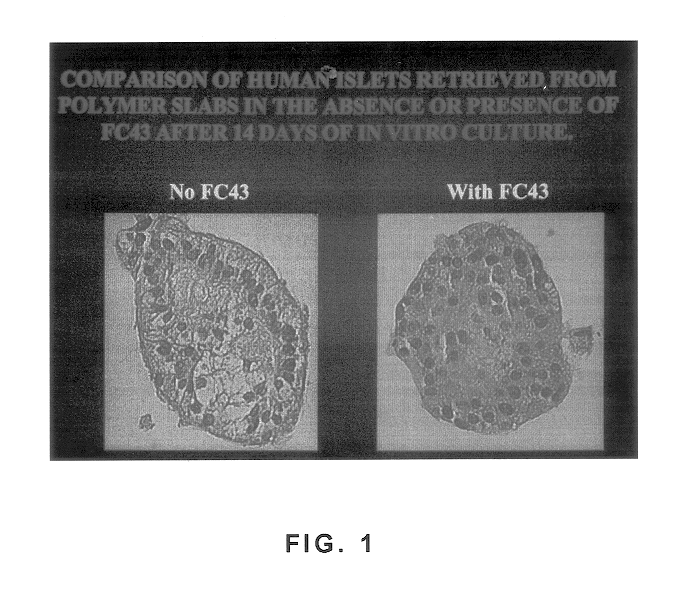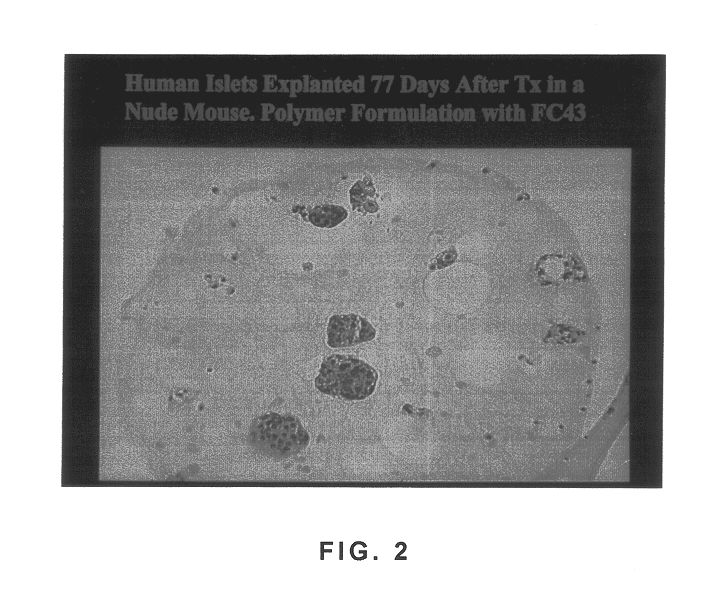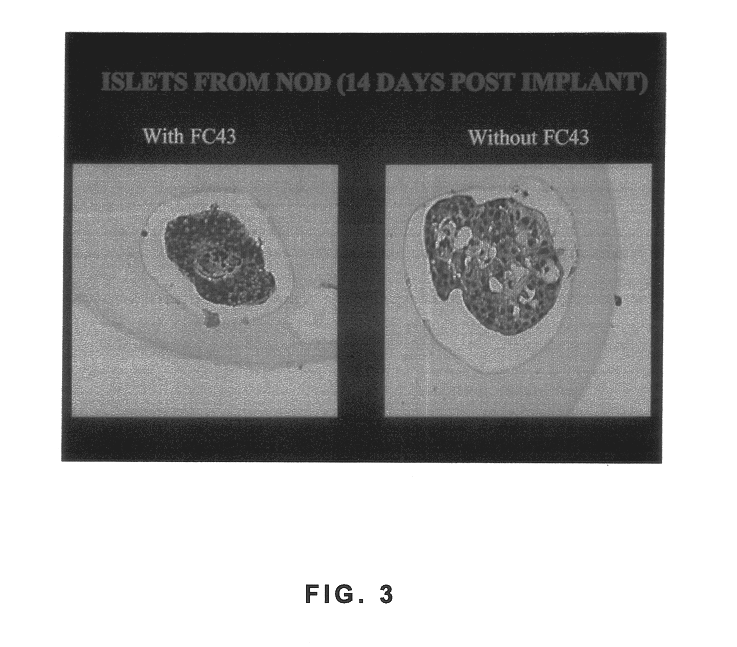Polymer formulations containing perfluorinated compounds for the engineering of cells and tissues for transplantation that improves cell metabolism and survival, and methods for making same
a technology of perfluorinated compounds and polymer formulations, which is applied in the field of polymer formulations containing perfluorinated compounds, can solve the problems of cell death, lack of oxygen and nutrient transport across the polymer membrane, cell encapsulation/immunosolation field, etc., and achieves low mortality rate, high vitality, and in vitro long-term
- Summary
- Abstract
- Description
- Claims
- Application Information
AI Technical Summary
Benefits of technology
Problems solved by technology
Method used
Image
Examples
example 1
Preparation of the Reactant Solutions
Chondroitin sulfate: the commercial CIS used contains 70% of 4-sulfate and 30% of 6-sulfate; 2.5 g was allowed to dissolve in 25 ml 0.1 M sodium carbonate solution, to give a 100 mg / ml final concentration. In other formulations, higher concentrations of CIS are used, to give final concentrations of 150, 200 or 250 mg / ml.
Sodium alginate (5.0 g) was suspended in 45 ml of water, heated to 40.degree. C., after which another 30 ml water were added in 10 ml portions to facilitate dissolution and decrease viscosity of the final solution. The amount of sodium alginate used corresponds to 28.3 mmoles of the unit disaccharide residue of alginate (F.Wt.=176.2).
The polymer used in the encapsulation according to the present invention is known as Biodritin; a mixture used to prepare the polymer solution is 70% Sodium Alginate mixed with 30% CIS, with or without chemical cross-linking (See U.S. patent application Ser. No. 08 / 877,682 and WO98 / 49202). Generally, ...
example 2
Partial Protection of Calcium Binding Sites
The total blockage of the calcium sites in the alginate solution would require 6.5 ml of a 4.5 M CaCl.sub.2 solution, which is not practical to use. A 4.5 M calcium chloride stock solution was diluted 1:5 and 200 .mu.l portions were added at intervals to the sodium alginate solution. During additions, and thereafter, the solution was vigorously mixed with the aid of a power mixer to completely avoid formation of gel clumps. Eight such additions, plus one, were made, in a total of 1800 .mu.l, corresponding to 1.5 mmol of calcium ions added.
Biodritin preparations can also be made in which the calcium binding sites are blocked to a lesser extent, from 25% to 75% of that described above. This also results in soluble materials, provided the coupling with DVS is not extensive.
In applications where the s-IPN gel is prepared, protection of the calcium binding sites is not necessary, as there is no chemical reaction with the alginate component of Bi...
example 3
DVS-Coupling Reaction
Keeping the alginate gel with protected calcium binding sites under continuous, vigorous mixing, 25 ml of the CIS solution were added, at which time the solution viscosity decreased. The solution was rapidly homogenized by the vigorous mixing and the coupling reagent, DVS, was added in 10 portions of 0.3 ml each, under continuous mixing at 2-3 min intervals.
When DVS addition was complete the mixture was kept for 2 hours in a water bath at 40.degree. C. At the end of this interval the reaction mixture was slightly purple in color; it was removed from the water bath and left overnight at room temperature.
During the reaction steps, continuous mixing is required, which can be easily achieved with help of an electrical mixer with blades or paddles.
PUM
| Property | Measurement | Unit |
|---|---|---|
| oxygen partial pressures | aaaaa | aaaaa |
| oxygen partial pressures | aaaaa | aaaaa |
| oxygen partial pressures | aaaaa | aaaaa |
Abstract
Description
Claims
Application Information
 Login to View More
Login to View More - R&D
- Intellectual Property
- Life Sciences
- Materials
- Tech Scout
- Unparalleled Data Quality
- Higher Quality Content
- 60% Fewer Hallucinations
Browse by: Latest US Patents, China's latest patents, Technical Efficacy Thesaurus, Application Domain, Technology Topic, Popular Technical Reports.
© 2025 PatSnap. All rights reserved.Legal|Privacy policy|Modern Slavery Act Transparency Statement|Sitemap|About US| Contact US: help@patsnap.com



